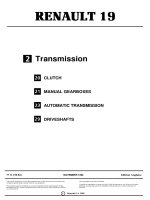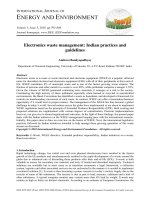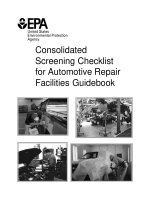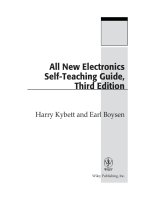Automobile electronics repair guide
Bạn đang xem bản rút gọn của tài liệu. Xem và tải ngay bản đầy đủ của tài liệu tại đây (7.65 MB, 148 trang )
&
4-stroke engines
ENGINE COMPUTER
ECU — ECM
ENGINE DIAGNOSTICS
OBD — II
OBD-II/SAE ACRONYMS
TURBINE and INTERCOOLER
DIAGNOSTIC ADVISOR
ENGINE SENSORS
MAF-MAP-CKP-KNOCK
O2-TPS-ECT-IAT-CID-CTS
ENGINE ACTUATOR
ISC-RGB-VTEC
ABS
FUELS and LUBRICANTS
Radovan MARIN
Author
Radovan Marin
General Automobile Engineer
British Institute of Engineering Technology
Aldermaston College
Reading, England
Reviewer
Dr. sc. Darko Biljaković
Editor
and
graphic design
Radovan Marin
Publisher
d.o.o.
ZAGREB
Kamaufova 2
www.auto-mart.hr
E-book
Zagreb, May 2011.
CIP record is available in the computer catalog of the National University
Library in Zagreb under the number
ISBN 978-953-95888-2-1
4
W
"A
M
au
pr
se
bo
ne
co
au
co
va
pr
ne
as
m
is
an
be
an
am
R E V I E W
With pleasure and interest I read the manual-tutorial book
"Automobile Electronics and 4-stroke engines”, written by Radovan
Marin.
Until recently, the electronic part of our car was a relatively
autonomous and far less developed than today. The latest models are
practically saturated with electronics and it is increasingly difficult to
separate mechanic from electronics. It is extremely fortunate to have a
book that combines a complex technical subject matter with practical
needs. Professional terminology is carefully selected, based on the
common technical language. Matter is uniformly distributed, where the
author deliberately avoids overly technical or scientific aspects, which
could excessively increase the scope of this book and reduce its practical
value, requiring extensive knowledge of the matter as well as great
practical experience.
The book abounds with illustrations, which are carefully selected to
neutralize the problem of many different types of vehicles and visually
assisting in understanding the basic principles of electronic and related
mechanical systems. The author very clearly shows how our modern car
is like a living organism where there is a complex interplay of electronics
and mechanics, as there is (of course much more complex) interaction
between the nervous and other vital systems. And finally he gives useful
and practical tips.
I believe that this book will be a great help to professionals and curious
amateurs.
Dr. sc. Darko Biljaković
5
A
pr
ele
U
m
pa
bu
tro
D
gin
kn
O
op
de
to
di
ev
re
de
wh
T
kn
of
6
FOREWORD
At the present time it is almost impossible to deal with cars, either
professionally or as a hobby, if we are not fully familiar with the vehicle
electronic elements.
Unlike the not-so-late seventies and eighties, when the vehicle repair and
maintenance required only the knowledge of mechanics, electrics and
partially electronics, today is almost unthinkable to get involved in such
business without good knowledge of electronics and functions of all electronic engine components.
Due to the lack of knowledge, today we often meet with expressions: engine computer or car electronics is gone. In fact, I used to say, if we do not
know how something works, there is no way to diagnose the problem.
Of course, today we commonly use diagnostic tools. But I often meet people who know how to read diagnostic trouble codes but not being able to
define the function of the defective element. In any case, the diagnostic
tools are a huge help in fault diagnosing. However, it often happens that
diagnostic device shows no error and malfunction of the vehicle engine is
evident. In such cases, knowledge comes to the fore. In addition, discovered diagnostic trouble code by diagnostic device does not give a concrete
definition of failure, but only focuses on a specific part of the engine on
which some tests have to be done to determine the malfunction.
Therefore, the purpose of this book is to introduce those with less
knowledge in the world of vehicle diagnostics and fundamental functions
of engine electronic components,
Author
7
Content:
Engine Control Unit and Engine Sensors ......................................
11
ECU, ECM Engine Control Unit ....................................................
14
CKP Crankshaft Position sensor ....................................................
20
CMP, CID Camshaft Position sensor .............................................
22
MAF Mass Airflow sensor ..............................................................
23
MAP Manifold Absolute Pressure sensor .....................................
27
IAT, MAT Intake Air Temperature sensor ..................................
29
KNOCK SENSOR detonation sensor ............................................
30
LAMBDA PROBE, O2, oxygen sensor ..........................................
32
CTS Coolant Temperature Sensor ................................................
35
TPS Throtthle Position Sensor........................................................
36
OBD On Board Diagnostics .............................................................
38
ISC Idle Speed Control actuator .....................................................
47
EGR Exhaust Gas Recirculation ...................................................
50
VTEC Variable Timing Camshaft ..................................................
52
CATALYTIC CONVERTER ........................................................
55
FOUR STROKE OTTO and DIESEL - ENGINES ....................
58
Engine ignition cycle ....................................................................
62
Ignition distributor ......................................................................
63
Transistor timing ..........................................................................
67
Ignition timing ..............................................................................
68
Spark plugs ...................................................................................
71
Carburators ..................................................................................
75
Vacuum carburators ....................................................................
80
Fuel pump .....................................................................................
82
Fuel injection ................................................................................
84
8
HI
SA
AB
OB
DI
FU
Mono-Jetronic ...............................................................................
86
K-Jetronic ......................................................................................
86
Diesel engine ..................................................................................
87
Turbine ..........................................................................................
91
Intercooler .....................................................................................
94
Timing belt and timing chain ......................................................
95
Engine lubrication system ............................................................
99
Engine cooling system ..................................................................
102
Alternator ......................................................................................
105
Electric engine starter ..................................................................
109
HID - Xenon lights .............................................................................
111
SAFETY AIR BAGS .........................................................................
113
ABS anti-blocking brake system ......................................................
116
Traction control ............................................................................
119
OBD II/SAE Acronyms ....................................................................
120
DIAGNOSTIC ADVISOR
Vehicle completely out of electric power .....................................
124
Ignition lights on but engine won’t start .....................................
124
Engine turns but won’t start ........................................................
126
Increased fuel consumption ..........................................................
127
Erratic igling ..................................................................................
128
Rattling valves and cold engine ....................................................
130
Increased oil consumption ............................................................
131
Cylinder head gasket .....................................................................
135
Poor brake efficiency .....................................................................
138
FUELS AND LUBRICANTS
Engine fuels ...................................................................................
141
Engine oil .......................................................................................
143
9
E
lar
ca
EC
EC
th
m
ics
co
en
th
am
tio
etc
tro
10
ENGINE CONTROL UNIT
(ECU, ECM)
and
ENGINE SENSORS
Engine control unit, or as popularly known, engine computer,
carries the original title of the
ECU (Engine Control Unit) or the
ECM (Engine Control Module).
The word, control unit, tells us
that this is the most important element of an motor vehicle electronics. This, indeed we may say a
seconds with received data and
sets the operating parameters.
Simply put, the control units regulates the fuel injection timing and
its amount. More sophisticated devices in modern cars regulate ignition timing, variable camshaft
VCT (Variable Cam Timing), the
amount of intake air and amount
A typical example of a control unit, usually located in the engine
area or in the cabin.
computer, collects data from all
engine sensors and on the basis of
these parameters determines the
amount of fuel and time of injection, ignition timing, engine idling,
etc. In any case, very complex electronic device which deals in milli-
of compressed air from turbocharger as well as other engine peripherals.
The control unit determines the
amount of fuel injected and the
moment of ignition on the basis of
received parameters from a series
11
of sensors, which are connected to
it. Sensors will show the parameters of the incoming airflow to the
ign
in
kn
sp
th
sla
an
us
Throttle position sensor - TPS sensor
One of the types of MAF sensor
engine intake manifold MAF
(Mass Air Flow sensor) and air
MAP sensor
pressure in the inlet manifold
MAP (Manifold Absolute Pressure
sensor), a butterfly throttle position, air temperature in intake
manifolds, engine coolant temperature, crankshaft position
(CKP sensor) and others.
Processing the received parameters in milliseconds, the control
unit will determine the quantity of
12
injected fuel into the engine cylinders. When accelerating the engine, quantity of fuel will be proportionately increased thanks to
input from sensors. Following the
coolant temperature, the control
unit will increase the amount of
fuel injected and will also gradually reduce it as coolant temperature increases.
The control unit (hereinafter re-
CKP crankshaft sensor
ferred to as ECU) will adjust the
ignition timing. The main information to adjust the ignition timing
will come from the CKP sensor,
which at any time shows the position of the engine crankshaft. In
determining the ignition angle, the
other sensor will help by registering the internal vibrations and engine knocking due to premature
C
als
pr
tem
ab
co
fu
at
en
pr
gin
ignition, which is often caused by
inadequate fuel. This sensor is
known as KNOCK sensor. In response to the vibrations signals of
the sensor inside the engine and
slamming, the ECU will adjust the
angle of ignition to the fuel being
used.
Certainly, we must not forget the
Lambda probe, or the original
name O2 sensor (oxygen sensor).
This chemical generator, will generate pulses of different voltage
values. Voltage will vary depending on difference amounts of oxygen in the engine exhaust gases
and atmospheric air. Registering
different values of momentum, the
ECU will automatically decrease
or increase the amount of injected
fuel.
KNOCK sensor
Coolant temperature sensor is
also connected to the ECU and
provides information about its
temperature. Disposal of data
about temperature, the ECU will
correct dosage amount of injected
fuel. This type of control mixtures
at different temperatures of the
engine eliminates all the known
principles of the, so-called, the engine "choke".
Lambda probe or (O2) OXYGEN sensor
Coolant Temperature Sensor
These are the basic components
of engine electronic control operation. That is, the ECU, as the brain
of motor management, collects information from connected sensors
and controls the engine by the factory installed programs.
13
ENGINE CONTROL UNIT
(ENGINE COMPUTER)
or
ECU, ECM
As can be seen in the above
photo, multipin outlet is planned
to connect the ECU with the engine sensors and other electrical
and electronic elements of the engine. ECU is usually located in the
cabin, but often can be found in
the space of the engine compartment, as well as on the engine it
self. Multipin plug is attached by
screw or various kinds of coupling
to the ECU. Such coupling will
provide a good plug connector
contact, as well as a seal between
the plug and socket. Seal between
the plug and socket is of great importance. Specifically, current and
voltage flowing between the ECU
and sensors have very small values. For that reason, contacts supposed to be perfectly clean. The
presence of moisture or oxidation
14
will cause interruption in circuits
or short circuit between the terminals. This is the reason, why accommodating ECU in the engine
area is very inappropriate. Located in such way, ECU-s are exposed to moisture and are subject
to breakdown due to oxidation of
contacts, either at the socket, or
inside the computer. Regardless of
the good sealing enclosures and
computer outlet, moisture will
eventually find its way into their
interior to create an oxide layer
between the contacts and soldered
surfaces. The consequences of failures in electronic systems of vehicles, caused by oxidation of compounds, usually can be solved with
contact anticorrosive solvents. In
case of failure of the ECU where
the presence of oxidation is visible,
th
so
Th
so
T
tip
m
nu
Ho
pl
W
gin
fro
pr
ele
tu
B
sio
da
an
po
th
the problem can be solved by resoldering all soldered contacts.
This problem is known as a "cold
solder" joint.
The above photo shows the multipin plug with sealing cover removed. Of course such a large
number of wires acts confusing.
However, it also indicates the complexity of the ECU’s function.
With this many power lines engine computer collects information
from all engine sensors, and after
processing, sends a commands to
electric and electronic engine actuators.
Before the world’s law of emission control was defined and standardized by the amount of pollutants and toxic exhaust gases, it was
possible to produce cars without
the use of electronics and micro-
processors. Stricter laws forced
auto industry to introduce more
sophisticated methods of mixing
fuel and air in order to obtain a
correct mixture ratio, and hence
more complete combustion. It means, only after the complete combustion of air-fuel mixture a catalyst can do its part, removing the
rest of harmful gas emissions.
Controlling the engine is the biggest task of ECU. It is also the
most powerful computer in the vehicle. ECU uses all the output parameters from engine and on its
base provides the input information and commands. Collecting
dozens of information from various sensors on the engine, the ECU
knows everything from the engine
coolant temperature to the amount
of oxygen in the exhaust.
15
Knock sensor
Air temperature sensor
CKP sensor
Coolant temperature sensor
Lambda probe or (O2) sensor
MAF sensor
MAP sensor
Based on data supplied by the
engine sensors, computer performs
millions of calculations per second,
combining the mathematical
equations for the optional ignition
timing and duration of fuel injection into the engine. All these acts
are performed by the ECU in order to reduce emission and achieve
less consumption and
simultaneously using the
maximum engine power.
Today’s motor vehicles are using
32-bit processor in ECU-s with
frequency of 40 MHz. The speed of
such processor may not look impressive in relation to home computers with a processor speed of
up to 3 GHz and more. But keep in
mind that the codes which are processed by the ECU processor take
only 1 MB of memory, while programs that we use on home compu16
TPS sensor
ters are taking up to 2 GB of
memory. Thus, two thousands times less memory for processing.
Comparing the weight of processing data in MB’s, we get very impressive picture of ECU’s processor speed. But certainly, the processor of 40 MHz is ot the upper
limit used in engine computers. In
some modified vehicles with improved engine performances, we
will find processors with frequency
up to 1 GHz.
The processor is installed in the
housing (module) along with hundreds of other components that
make up the ECU. Some of the
components which support the
processor are:
Analog-digital converters
These devices read the output
values of sensors, such as the lambda probe. The output value of
th
to
di
co
in
H
m
ne
ce
sin
fa
cti
tp
an
on
on
to
cu
to
to
pr
Th
en
tiv
th
ted
en
Fi
flo
Th
th
A
di
ve
ge
re
Ho
ce
an
wo
log
ar
this sensor is analog voltage from 0
to 1.1 V. Processor recognizes only
digital numbers. Therefore, the
converter will convert the voltage
in 10-bit digital numbers.
High level digital outputs. On
most modern cars, ECU determines the moment of spark occurrence on spark plugs, opening and closing injectors, switching cooling
fan on and off, activating and deactivating fuel pump etc. Digital output can only be turned on or off
and there is not any middle situation or value. For example, to turn
on the engine cooling fan we have
to provide voltage of 12V and 0,5A
current to activate fan relay, or 0V
to turn it off. The question is, how
to get out so much power from
processor to activate fan relay.
The path is as follows: very low
energy from the processor will activate a transistor which also has
the same function as relay. Activated transistor will provide enough
energy to activate fan relay.
Finally, trough the fan relay will
flow enough energy to run the fan.
The same way, processor activates
the other engine actuators.
Digital-analog converters
As previously mentioned, analogdigital converters are used to convert analog signal to digital. It is
generally required when processor
receives analog sensor values.
However, when processor manages
certain engine components, digitalanalog converter is needed. Other
words, voltage is received as analog signal and digital commands
are sent to be converted to voltage.
This converter will convert digital
signal from processor to analog as
described and manage engine electric components.
Signal corrector. Due to a more
accurate reading of analog signal,
it must be corrected before the final readings in the processor. This
is the task of this corrector which
is adjusted to correct imprecise
signals.
Communications chip. This chip
is designed for communisation
with diagnostic devices. Diagnostic
devices are subject to communication protocols, which determines
communication chip. Since 1996.
until today, five communication
protocols are present on cars
worldwide. Today, on new vehicles
CAN (controller-area networking)
protocol is dominating. We shall
leave protocols aside for awhile
when we shall discuss the OBD II
diagnostics, which is unified for all
personal vehicles since 1996. year
to date in the US and good part of
vehicles in other parts of the
world. Since 2001. until 2003. year,
in Europe all personal vehicles are
subject to OBD II standards.
Microprocessor
17
m
an
Na
se
do
th
be
Ho
ap
be
lap
On middle-class vehicles, ECU is
mainly factory programmed and
can not be reprogrammed. However, on higher-classes vehicles,
computers are built with ability to
be reprogrammed and upgraded.
These computers can be updated
with the latest or modified software solutions for particular vehicle.
If the standard ECU installed in
the vehicle is not reprogrammable,
the market offers a wide range of
ECU's that can be programmed
and reprogrammed. One such example is shown in the above photo.
The investment of such ECU will
engage only the vehicle owner who
has made significant modifications
to the engine.
18
Significant modifications implies
the installation of modified camshafts, turbine, exhaust system,
intercooler etc. In such cases, the
original ECU probably would not
be able to follow the new engine
configuration and must be replaced by new ones, which can be
reprogrammed or mapped.
ECU, which can be programmed, provides the ability to
control the dispensing of fuel into
each cylinder, what will depend of
the butterfly throttle position and
accelerator pedal sensors, the
amount of intake air which information will provide MAF sensor,
and air pressure in the inlet manifold which we read through MAP
sensor. Such adjustments can be
se
re
Ba
m
co
th
m
en
m
pr
ne
pr
co
M
th
an
m
m
in
gin
made with appropriate programs
and a laptop or desktop computer.
Namely, the table of values read by
sensors and driving on them is
done programming or mapping
the ECU. Desktop computer can
be used if the vehicle is on rollers.
However, in the absence of such an
apparatus, the programming can
be done while driving and using a
laptop computer.
In the accompanying picture we
see read the parameters that are
relevant for programming ECU.
Based on the data and constantly
monitoring the lambda probe, the
computer can adjust the following:
the moment of ignition, limit the
maximum RPM, the turbine, cold
engine operation, fuel dispensing,
modifying the fuel injection at low
pressure in the system and permanent monitoring of the lambda
probe in order to achieve the ideal
combustion mixture.
Modifying the value while setting
the ECU, a lambda probe will at
any time have control over the
mixture and the tuner will determine the optimal amount of fuel
injected in all combinations of engine RPM and throttle butterfly
positions.
In more sophisticated models of
ECUs, which are used in car racing purposes, setup options are
even greater. For example, we can
limit the power of the engine in
first gear, so as not to damage the
engine and other vehicle parts. It is
possible to limit the power of the
turbine regulating valve routing
engine exhaust gases, to precisely
control twin injectors per cylinder,
which are used for precise dosage
of fuel and the atomization of fuel
injection when the larger engine
rpm. It is possible to control variable camshafts, or engine valve
opening duration and monitoring
of the engine when shifting sequential gearbox.
As already mentioned, the ECU
has a communication chip, which
allows us to check the accuracy of
all data and electronic elements of
the engine. However, in order to
let us know about possible irregularity of engine management or its
faulty before routine checking, the
ECU switches warning light on
dashboard which alerts drivers to
an irregularity or failure of the
engine. Such light is called a MIL
(Malfunction Indicator Lamp),
and marked with the CHECK ENGINE.
19
ENGINE SENSORS
CKP senzor
Crankshaft Position Sensor
A
th
pe
rim
co
of
th
to
lar
Crankshaft Position Sensor is a
component of an electronic engine
monitoring, which monitors the
crankshaft RPM and its position
relative to the piston upper dead
point (TDC). Information of this
sensor is used to determine the
moment of ignition and fuel injection. Crankshaft sensor is typically
used in combination with a similar
camshaft sensor. This combination
determines the correct relationships of engine pistons and valves.
This combination is extremely important in engines with variable
camshaft. However, in the middle
class cars, only crankshaft sensor
20
is sufficient. Crankshaft and camshaft sensors consist of a core - a
permanent magnet and induction
coil around the core.
CKP sensor is usually located on
the front of the crankshaft or the
engine flywheel housing.
fly
Th
fie
cr
m
th
en
a
wi
m
shaft position.
As shown in the drawing above,
the sensor is located close to the
perforated or serrated flywheel
rim. The same situation is with accommodating sensors on the front
of the crankshaft, in which case
the sensor is located along the
toothed timing belt pulley.
In the basic variant, the annular part of the crankshaft pulley or
flywheel has 36 teeth, minus 1
Thirty-six teeth is the measuring
field of a cycle of turning the
crankshaft for 360 °. One tooth
missing, determines the position of
the crankshaft. Of course, different models of vehicles would have
a different arrangement of teeth,
with the purpose of obtaining
more information about crank-
Thus, CKP sensor is a generator.
Just by turning the engine starter,
the sensor will, meeting the pulley
teeth, generate voltage up to ten
volts, depending of the type of vehicle. Previously, it was said that
the notched part of one tooth is
missing. Passing that part of pulley breaks the continuity of the
voltage pulse and it will be information for the ECU in which position is engine crankshaft.
It is important to take into account the distance between the
sensor and the top of the teeth,
which is determined by the vehicle
manufacturer. It should also be
taken into account that between
the sensor and the teeth, or in the
grooves between the teeth, must
not be metal particles.
Checking CKP sensor is very
simple. It is necessary to disconnect the sensor connector and do
the following: For example, on the
VW Golf 1.4, 1998. Year, we will
find a connector with three terminals. Terminals 1 and 3 are connected to the engine computer,
while terminal 2 is connected to
the ground pole of the engine.
Connecting voltmeter to terminals
1 and 3, while simultaneously
turning the engine starter, should
get a voltage reading of 4.5 V. Terminal 2, which is connected to the
21
ground of the engine is wire mesh
covering the terminals 1 and 3.
This layer will prevent any external voltage influence on the voltage
generated by sensors. That is, if
the behavior occurs, it will lose its
unwanted stress on the ground
pole (ground is called negative or
minus pole on cars). Checking the
sensor can be performed by measuring the resistance between terminals 1 and 3, if we know the
value of resistance.
Finally as described, CKP sensor
usually will find in today's vehicles. These sensors send analog signals, which are in the engine computer converted to digital. However, in some types of vehicles, we
find the sensors that send digital
signals. Such sensors have built-in
converters, which convert analog
signals to digital and thus relieve
the ECU of that task.
CMP - CID sensor
(Camshaft Position Sensor)
Camshaft sensor works the same
way as the CKP sensor. Based on
the CMP sensor pulses ECU will
control the moment of ignition and
synchronize the fuel injection. This
sensor is also known as sensor CID
22
(Cylinder Identification Sensor).
Given the information that the
ECU uses to control engine operation, a result of failure of this sensor does not necessarily mean the
engine failure, as is the case with
the CKP sensor. But in any case,
there will be incorrect fuel injection and loss of engine performance. Certainly, in this case MIL
warning light will flash.
Unlike the serration of the
crankshaft pulley, cam shaft may
have only one nose marking the
first cylinder. However, as shown
in the drawing below, there may
be more teeth. This, of course, depends on the concept of electronic
engine management of particular
vehicle.
gin
m
th
se
ca
be
pa
tem
en
en
ra
ies
on
lat
m
T
M
VA
a
W
wo
No
m
MAF senzor
Mass Airflow Sensor
This sensor is inevitable on engines with electronic fuel injection,
measuring the air mass entering
the engine. This information is essential to the engine computer to
calculate the mixture, which will
be prepared for combustion.
Air changes its density as it expands and contracts at different
temperatures. Given that, vehicle
engines are operating under different conditions and temperature
ranges where the mass of air varies. This is an ideal sensor; based
on whose data the ECU can calculate the proper ratio of fuel and air
mixture.
The two most common types of
MAF sensors that we meet are
VANE METER airflow meter with
a vane or blades and a HOT
WIRE air flow meter, which
works on the principle of hot wire.
None of them was designed to
measure air mass completely.
However, in combination with
temperature and air pressure sensors, air mass can be safely calculated with great precision. Both
sensors send analog voltage signals
0-5 volts in proportion to the mass
flow rate.
Described sensors can be found
in vehicles produced until 2000.
Year. Since that time, the same
sensors are considerably modified,
and VANE sensors we almost do
not see any more. In HOT WIRE
sensors membrane foils are inserted instead of wires, and other
various modifications are made.
However, these sensors are still
working on the same principle as
previous. In newer vehicles we
rarely find sensors with analog signals. In fact, today more and more
sensors have built-in converter
and send digital signals to the
ECU. Such sensors have been recognized as part of an electronic
structure is usually visible.
VANE MAF sensors operate on
the principle of moving vanes or
blades which is associated with a
potentiometer or sliding resistor.
By entering the air through the
sensor, the sensor flap opens due
to the force of air pressure. Of
course, the degree of openness of
the wings or blades will depend on
the amount of air flow. Flap is mechanically connected with resis23
tor’s slider, which will alter the
voltage value depending on the position of wings, or slide.
On the coil of the potentiometer
the power has been brought. The
slider of the potentiometer, which
will in any position close the electrical circuit between the part of
coil and the source of power will
reduce or increase the output voltage from the coil. As shown in the
attached sketch, we put a volt meter on the coil slider, moving the
wings and also the slider we get
different voltage values. The potentiometer is calibrated so that
from zero to full fins deflection
gives the voltage in the range 0-5
V. The readout voltage of ECU
subject to failures. Failures are
mostly related to improper flap
deflection due to dirt deposits on
the pin about which it rotates.
The next problem is the size of
the flap mechanism within the sensor, which prevents the maximum
air flow through the sensor. In addition, the mechanical parts such
as springs, changing its calibrated
value over time. For that reason,
these sensors have a mechanism
for adjusting the tension of fins
spring. Namely, if the spring
weakens over time, the deflection
of the potentiometer will be higher
than provided for the incoming air
mass. In other words, the ECU will
receive for smaller amount of air a
VANE MAF sensor
will turn into a mass of air g / s
(grams per second).
Such sensors have proved to be
impractical for several reasons.
Since they were made from quite a
few mechanical parts, they are
24
higher value in volts and so dose
the greater amount of fuel. Surely,
this will cause a rich mixture and
higher fuel consumption, as well as
loss of engine power. These were
the reasons for MAF modification.
H
at
wh
di
di
di
wh
5V
S
I
we
sp
in
so
sk
flo
ne
wi
flo
it,
cr
sis
Pe
flo
ul
na
EC
HOT WIRE MAF sensors operate on the principle of heated wire,
which is cooled by air flow. The
difference in the wire resistance at
different temperatures will cause
differences in the analog signal
whose value varies between 0 and
5V.
Wire
Sensor
Unlike VANE sensors, this sensor will recognize the air density.
Namely, denser air cools the wire
more than thin air. In case of
denser air, sensor will send
stronger signal, just like that
greater volume of air flows trough
the sensor.
Today's sensors are increasingly
using alloy metal plates instead of
wire, and built-in modules instantly converting analog signals
to digital.
Housing
Sensor
Wire
Connector
Air
In the upper section of the sketch
we see MAF sensor with all its
specificities. Air enters the engine
intake manifold through the sensor housing. As can be seen on the
sketch, a small amount of air is
flowing through a separate channel in the casing. In this section is a
wire over which air flows. Current
flows through the wire and heats
it, while airflow cools it down. Increasing wire temperature, the resistance increases, and vice versa.
Permanent changes in current
flow through the sensor wire, module will convert it into Voltage signals 0-5 V and forward them to the
ECU.
Above photograph shows the typical modern car sensor with visible
electronic plate and module. The
presented sensor works on the
principle of thermal membrane. At
the plastic plate, which is located
in the middle of the housing, the
membrane is imprinted with the
metal foil on the bottom and top.
Membrane warms foil plates,
which react in the same way as the
wire, but far more precise.
Today are also increasingly present sensors with the so-called cold
wire. With these sensors, due to air
flow induces a voltage, which goes
to the ECU in the form of digital
signals.
25









